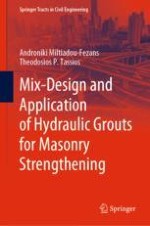This book provides guidance for the rational design and application of hydraulic grouts, based on a series of specific data (type of masonry, voids' width, targeted strength and durability level, available materials, etc.). To this end, the basic characteristics of a grout, i.e. its injectability (penetrability, fluidity and stability), its strength and durability, are taken into account by means of rational models and quantified expressions of all grout-design parameters. Thus, a holistic, rational mix design methodology for optimization of grout composition is given, permitting the preliminary design of grouts, without having to resort to multiple tests in advance. Moreover, detailed practical guidelines for grouting application and quality control, based on real case studies, are also included. The book attempts to rationalize the entire procedure of this poly-parametric decision-making, keeping however in mind the need for practical engineering solutions.
